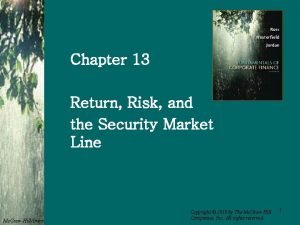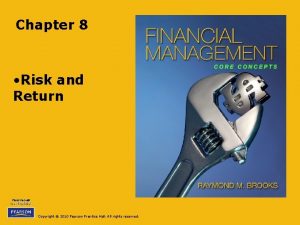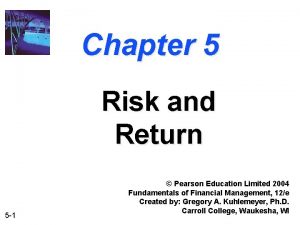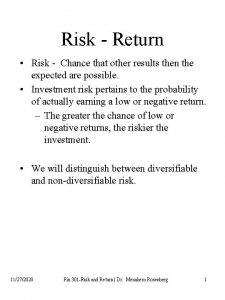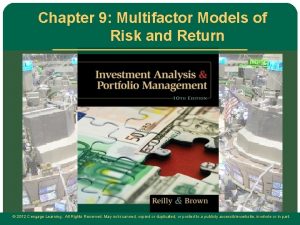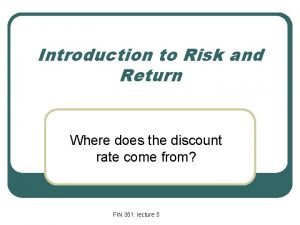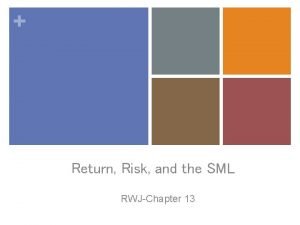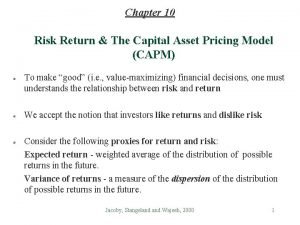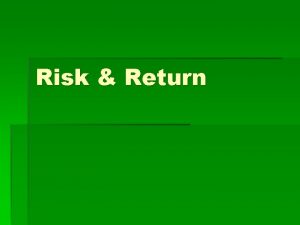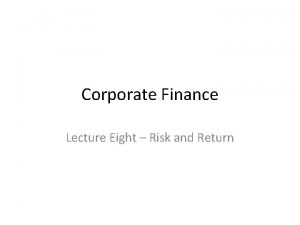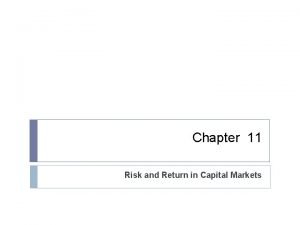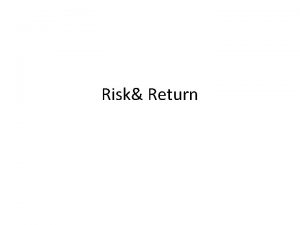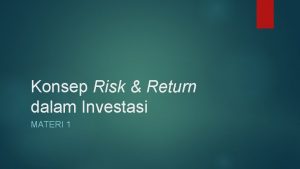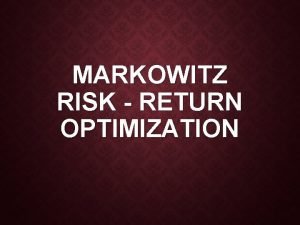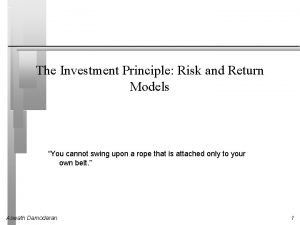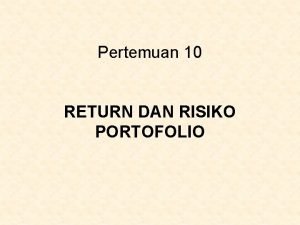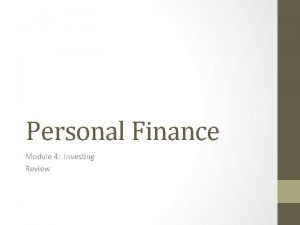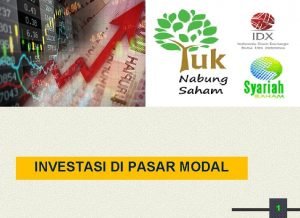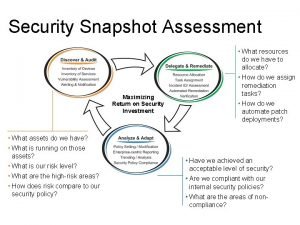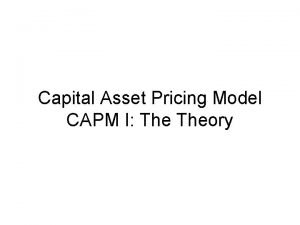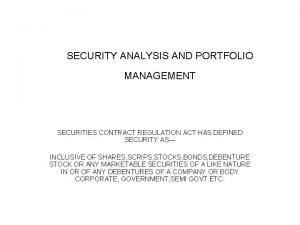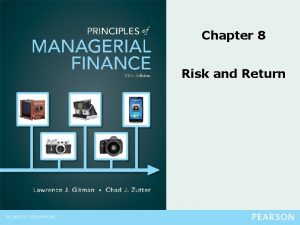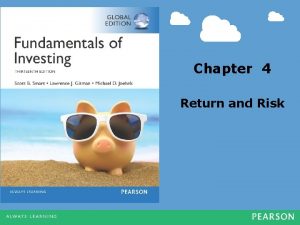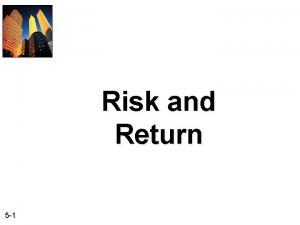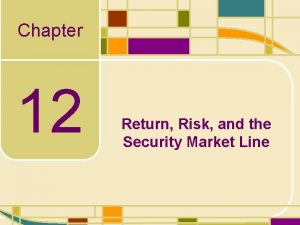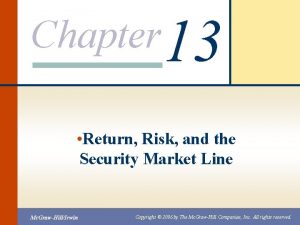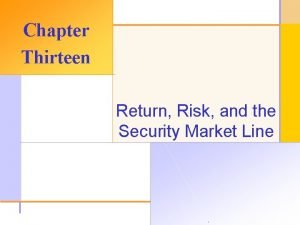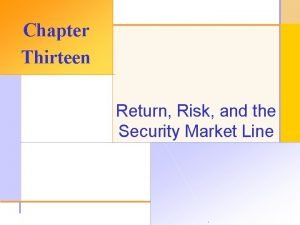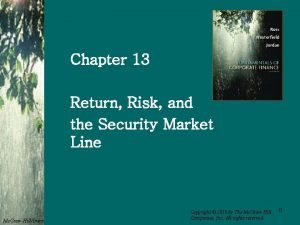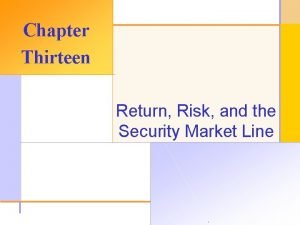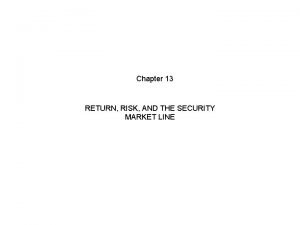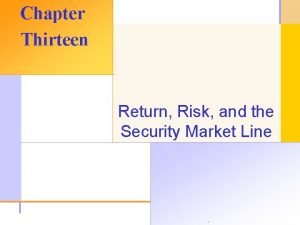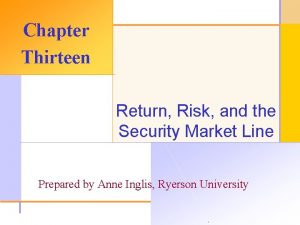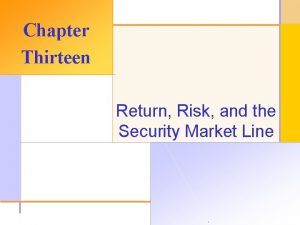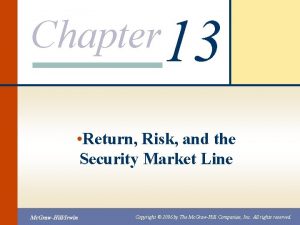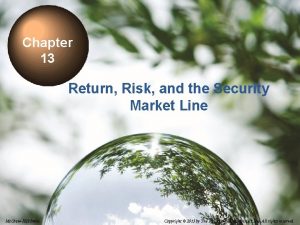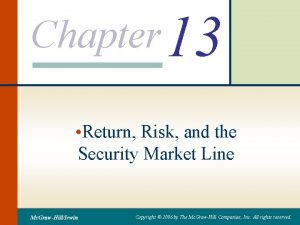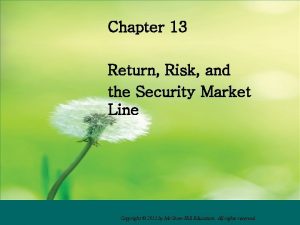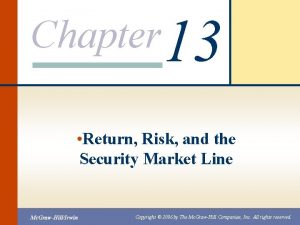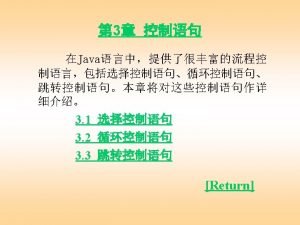CHAPTER 13 RETURN RISK AND THE SECURITY MARKET


































- Slides: 34

CHAPTER 13 RETURN, RISK, AND THE SECURITY MARKET LINE Copyright © 2016 by Mc. Graw-Hill Global Education LLC. All rights reserved.

EXPECTED RETURNS • Expected returns are based on the probabilities of possible outcomes • In this context, “expected” means average if the process is repeated many times • The “expected” return does not even have to be a possible return Copyright © 2016 by Mc. Graw-Hill Global Education LLC. All rights reserved. 13 -2

EXAMPLE: EXPECTED RETURNS • Suppose you have predicted the following returns for stocks C and T in three possible states of the economy. What are the expected returns? State Boom Normal Recession Probability 0. 3 0. 5 ? ? ? C 0. 15 0. 10 0. 02 T___ 0. 25 0. 20 0. 01 • RC =. 3(15) +. 5(10) +. 2(2) = 9. 9% • RT =. 3(25) +. 5(20) +. 2(1) = 17. 7% Copyright © 2016 by Mc. Graw-Hill Global Education LLC. All rights reserved. 13 -3

VARIANCE AND STANDARD DEVIATION • Variance and standard deviation measure the volatility of returns • Using unequal probabilities for the entire range of possibilities • Weighted average of squared deviations Copyright © 2016 by Mc. Graw-Hill Global Education LLC. All rights reserved. 13 -4

EXAMPLE: VARIANCE AND STANDARD DEVIATION • Consider the previous example. What are the variance and standard deviation for each stock? • Stock C § 2 =. 3(0. 15 -0. 099)2 +. 5(0. 10 -0. 099)2 +. 2(0. 02 -0. 099)2 = 0. 002029 § = 4. 50% • Stock T § 2 =. 3(0. 25 -0. 177)2 +. 5(0. 20 -0. 177)2 +. 2(0. 01 -0. 177)2 = 0. 007441 § = 8. 63% Copyright © 2016 by Mc. Graw-Hill Global Education LLC. All rights reserved. 13 -5

ANOTHER EXAMPLE • Consider the following information: State Boom Normal Slowdown. 15 Recession. 10 Probability. 25. 50 ABC, Inc. Return 0. 15 0. 08 0. 04 -0. 03 • What is the expected return? • What is the variance? • What is the standard deviation? Copyright © 2016 by Mc. Graw-Hill Global Education LLC. All rights reserved. 13 -6

PORTFOLIOS • A portfolio is a collection of assets • An asset’s risk and return are important in how they affect the risk and return of the portfolio • The risk-return trade-off for a portfolio is measured by the portfolio expected return and standard deviation, just as with individual assets Copyright © 2016 by Mc. Graw-Hill Global Education LLC. All rights reserved. 13 -7

EXAMPLE: PORTFOLIO WEIGHTS • Suppose you have $15, 000 to invest and you have purchased securities in the following amounts. What are your portfolio weights in each security? § $2000 of C § $3000 of KO § $4000 of INTC § $6000 of BP § § C: 2/15 =. 133 KO: 3/15 =. 2 INTC: 4/15 =. 267 BP: 6/15 =. 4 Copyright © 2016 by Mc. Graw-Hill Global Education LLC. All rights reserved. 13 -8

PORTFOLIO EXPECTED RETURNS • The expected return of a portfolio is the weighted average of the expected returns of the respective assets in the portfolio • You can also find the expected return by finding the portfolio return in each possible state and computing the expected value as we did with individual securities Copyright © 2016 by Mc. Graw-Hill Global Education LLC. All rights reserved. 13 -9

EXAMPLE: EXPECTED PORTFOLIO RETURNS • Consider the portfolio weights computed previously. If the individual stocks have the following expected returns, what is the expected return for the portfolio? § § C: 19. 69% KO: 5. 25% INTC: 16. 65% BP: 18. 24% • E(RP) =. 133(19. 69%) +. 2(5. 25%). 267(16. 65%) +. 4(18. 24%) = 15. 41% Copyright © 2016 by Mc. Graw-Hill Global Education LLC. All rights reserved. + 13 -10

PORTFOLIO VARIANCE • Compute the portfolio return for each state: R P = w 1 R 1 + w 2 R 2 + … + w m. R m • Compute the expected portfolio return using the same formula as for an individual asset • Compute the portfolio variance and standard deviation using the same formulas as for an individual asset Copyright © 2016 by Mc. Graw-Hill Global Education LLC. All rights reserved. 13 -11

EXAMPLE: PORTFOLIO VARIANCE • Consider the following information on returns and probabilities: § Invest 50% of your money in Asset A State Boom Bust Probability. 4. 6 A 30% -10% B -5% 25% Portfolio 12. 5% 7. 5% • What are the expected return and standard deviation for each asset? • What are the expected return and standard deviation for the portfolio? Copyright © 2016 by Mc. Graw-Hill Global Education LLC. All rights reserved. 13 -12

ANOTHER EXAMPLE • Consider the following information on returns and probabilities: State Boom Normal Recession. 15 Probability. 25. 60 5% X 15% 10% Z 10% 9% 10% • What are the expected return and standard deviation for a portfolio with an investment of $6, 000 in asset X and $4, 000 in asset Z? Copyright © 2016 by Mc. Graw-Hill Global Education LLC. All rights reserved. 13 -13

EXPECTED VS. UNEXPECTED RETURNS • Realized returns are generally not equal to expected returns • There is the expected component and the unexpected component § At any point in time, the unexpected return can be either positive or negative § Over time, the average of the unexpected component is zero Copyright © 2016 by Mc. Graw-Hill Global Education LLC. All rights reserved. 13 -14

SYSTEMATIC RISK • Risk factors that affect a large number of assets • Also known as non-diversifiable risk or market risk • Includes such things as changes in GDP, inflation, interest rates, etc. Copyright © 2016 by Mc. Graw-Hill Global Education LLC. All rights reserved. 13 -15

UNSYSTEMATIC RISK • Risk factors that affect a limited number of assets • Also known as unique risk and asset-specific risk • Includes such things as labor strikes, part shortages, etc. Copyright © 2016 by Mc. Graw-Hill Global Education LLC. All rights reserved. 13 -16


DIVERSIFICATION • Portfolio diversification is the investment in several different asset classes or sectors • Diversification is not just holding a lot of assets • For example, if you own 50 Internet stocks, you are not diversified • However, if you own 50 stocks that span 20 different industries, then you are diversified Copyright © 2016 by Mc. Graw-Hill Global Education LLC. All rights reserved. 13 -18

THE PRINCIPLE OF DIVERSIFICATION • Diversification can substantially reduce the variability of returns without an equivalent reduction in expected returns • This reduction in risk arises because worse than expected returns from one asset are offset by better than expected returns from another • However, there is a minimum level of risk that cannot be diversified away and that is the systematic portion Copyright © 2016 by Mc. Graw-Hill Global Education LLC. All rights reserved. 13 -19

FIGURE 13. 1 Copyright © 2016 by Mc. Graw-Hill Global Education LLC. All rights reserved. 13 -20













TOTAL VS. SYSTEMATIC RISK • Consider the following information: Standard Deviation Beta Security C 20% Security K 1. 25 30% 0. 95 • Which security has more total risk? • Which security has more systematic risk? • Which security should have the higher expected return? Copyright © 2016 by Mc. Graw-Hill Global Education LLC. All rights reserved. 13 -33

EXAMPLE: PORTFOLIO BETAS • Consider the previous example with the following four securities Security C KO INTC BP Weight Beta. 133. 2. 267. 4 2. 685 0. 195 2. 161 2. 434 • What is the portfolio beta? • . 133(2. 685) +. 2(. 195) +. 267(2. 161) +. 4(2. 434) = 1. 947 Copyright © 2016 by Mc. Graw-Hill Global Education LLC. All rights reserved. 13 -34
 Chapter 13 return risk and the security market line
Chapter 13 return risk and the security market line Credit risk market risk operational risk
Credit risk market risk operational risk Financial management chapter 8 risk and return
Financial management chapter 8 risk and return Chapter 8 risk and rates of return problem solutions
Chapter 8 risk and rates of return problem solutions Chapter 5 risk and return
Chapter 5 risk and return Private secruity
Private secruity Objectives of segmentation
Objectives of segmentation Leader challenger
Leader challenger Risk and return
Risk and return The risk per unit of return is measured by the
The risk per unit of return is measured by the Risk and return
Risk and return Multifactor model of risk and return
Multifactor model of risk and return Introduction to risk and return
Introduction to risk and return Risk and return
Risk and return Calculate expected portfolio return
Calculate expected portfolio return Materi risk and return
Materi risk and return Difference between risk and return
Difference between risk and return Difference between risk and return
Difference between risk and return Risk and return
Risk and return Konsep risk and return
Konsep risk and return Markowitz model of risk return optimization
Markowitz model of risk return optimization Risk return principle
Risk return principle Rumus risiko portofolio
Rumus risiko portofolio The basic rule of a risk-to-return relationship is that …
The basic rule of a risk-to-return relationship is that … High risk high return artinya
High risk high return artinya Maximizing security roi
Maximizing security roi Risk premium capm
Risk premium capm Residual risk and secondary risk pmp
Residual risk and secondary risk pmp Business vs financial risk
Business vs financial risk Relative risk and attributable risk
Relative risk and attributable risk Relative risk and attributable risk
Relative risk and attributable risk Risk in security analysis and portfolio management
Risk in security analysis and portfolio management Wireless security in cryptography and network security
Wireless security in cryptography and network security E commerce security policy
E commerce security policy Primary target market and secondary target market
Primary target market and secondary target market
